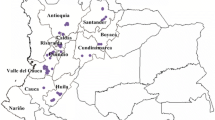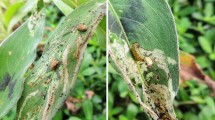Abstract
The incidence of the American serpentine leafminer, Liriomyza trifolii (Burgess) (Diptera: Agromyzidae) was studied in cotton-growing tracts of Tamil Nadu State, India. The incidence Was higher on summer than on winter cotton and the cropping pattern was found to have an impact on the incidence of the leafminer on cotton. Biological studies on L. trifolii conducted on cotton, Gossypium hirsutum L., tomato, Lycopersicon esculentum Mill., and cowpea, Vigna sinensis (L.) Walp., revealed that its life cycle varied with different hosts. The duration of the pupal stage of L. trifolii was the longest in the leafminer’s life cycle. Lycopersicon esculentum was the preferred host—females of L. trifolii survived the longest and had the highest fecundity on this host. Sex discrimination was possible at the pupal stage, on the basis of size; female adults were found to emerge from larger-sized pupae and males from smaller ones.
Résumé
L’incidence de la larve sinueuse américaine des feuilles, Liriomyza trifolii (Burgess) (Diptera: Agromyzidae) a été étudiée dans les périmètres cotonniers de l’Etat du Tamil Nadu, en Inde. Cette incidence était plus prononcée sur le coton estival que sur le coton hivernal. Le système de cultures avait un impact sur le taux d’incidence de la mineuse sur le coton. Les études biologiques menées sur le coton, Gossypium hirsutum; le niébé, Vigna sinensis (L.) Walp. et la tomate Lycopersicon esculentum Mill., ont révelé que le cycle biologique de L. trifolii varie selon les différentes plantes hôtes. Le stade chrysalide de L. trifolii était le plus long du cycle bilogique. On a déduit que L. esculentum était l’hôte préféré de L. trifolii en se basant sur la plus longue survie et la fécondité élevée de l’insecte sur cette plante. Il était possible de différencier les sexes au niveau des chrysalides sur base de leur taille. Les femelles adultes émergeaient des chrysalides de grande taille tandis que mâles, de celles de petite taille.
Similar content being viewed by others
References
Anonymous (1991) Castor: Annual Progress Report. 137 pp. Directorate of Oilseeds Research, Hyderabad, India.
Baufeld P. and Motte G. (1992) On the biology and economic importance of Liriomyza trifolii (Burgess). Nachr Bl. dt. Pflschutzdenst. 44, 225–229.
Chandler L. D. and Gilstrap F. E. (1987) Seasonal fluctuations and age structure of Liriomyza trifolii (Diptera: Agromyzidae) larval populations on bellpeppers. J. Econ. Entomol. 80, 102–106.
Fagoonee I. and Toory V. (1983) Preliminary investigations of host selection mechanisms by leaf miner, Liriomyza trifolii. Insect Sci. Applic. 4, 337–341.
Fagoonee I. and Toory V. (1984) Contribution to the study of biology and ecology of the leafminer Liriomyza trifolii and its control by neem. Insect Sci. Applic. 5, 23–30.
Gomez K. A. and Gomez A. A. (1984) Statistical Procedures for Agricultural Research. John Wiley & Sons, New York. 680 pp.
Jagannatha R. (1994) Comparative biology, ecology and management of American serpentine leafminer Liriomyza trifolii (Burgess) (Diptera: Agromyzidae). MSc Thesis, University of Agricultural Sciences, Bangalore, India. 126 pp.
Jeyakumar P. and Uthamasamy S. (1996) Ecological barrier for Liriomyza trifolii (Burgess). Insect Environ. 2, 55–56.
Jeyakumar P. and Uthamasamy S. (1997) Mass rearing of American serpentine leafminer, Liriomyza trifolii (Burgess) (Diptera: Agromyzidae). Entomon 22, 243–245.
Lakshminarayana M., Basappa H. and Vijayasingh R. (1992) Report on the incidence of hitherto unknown leafminer (Agromyzidae) on castor. J. Oilseeds Res. 9, 175–176.
Leibee G. L. (1984) Influence of temperature on development and fecundity of Liriomyza trifolii (Burgess) (Diptera: Agromyzidae). Environ. Entomol. 13, 497–501.
Minkenberg O. P. J. M. and Helderman C. A. J. (1990) Effect of temperature on the life history of Liriomyza bryoniae (Diptera: Agromyzidae) on tomato. J. Econ. Entomol. 83, 117–125.
Natarajan K., Shanthi P. and Chitra K. (1994) Host range of Liriomyza trifolii. A newly introduced pest to India. J. Appl. Zool. Res. 5, 113–115.
Oatman E. R. and Michelbacher A. E. (1958) The melon leafminer, Liriomyza pictella (Thomson) (Diptera: Agromyzidae). Ann. Entomol. Soc. Am. 51, 557–566.
Oatman E. R. and Michelbacher A. E. (1959) The melon leafminer Liriomyza pictella (Thomson) (Diptera: Agromyzidae). II. Ecological studies. J. Econ. Entomol. 52, 83–89.
Parrella M. P. (1987) Biology of Liriomyza. Annu. Rev. Entomol 32, 201–224.
Parrella M. P. and Robb K. L. (1982) Technique for staining eggs of Liriomyza trifolii within chrysanthemum, celery and tomato leaves. J. Econ. Entomol. 75, 383–384.
Parrella M. P., Robb K. L. and Bethke J. (1983) Influence of selected host plants on the biology of Liriomyza trifolii (Diptera: Agromyzidae). Ann. Entomol. Soc. Am. 76, 112–115.
Parrella M. P., Robb K. L., Virzi J. K. and Dybas R. A. (1988) Analysis of the impact of abamectin on Liriomyza trifolii (Burgess) (Diptera: Agromyzidae). Can. Entomol. 120, 831–837.
Srinivasan K., Viraktamath C. A., Gupta M. and Tewari G. C. (1995) Geographical distribution, host range and parasitoids of serpentine leafminer, Liriomyza trifolii in South India. Pest Manage. Hort. Ecosyst. 1, 93–100.
Viraktamath C. A., Tewari G. C., Srinivasan K. and Gupta M. (1993) American serpentine leafminer; a new threat to crops. Indian Farming 10, 12.
Zoebisch T. G. and Schuster D. J. (1987) Longevity and fecundity of Liriomyza trifolii (Diptera: Agromyzidae) exposed to tomato foliage and honeydew in the laboratory. Environ. Entomol. 16, 1001–1003.
Zoebisch T. G., Schuster D. J., Smerage G. I. and Stimac J. L. (1992) Mathematical descriptions of oviposition and egg and larval development of Liriomyza trifolii (Diptera: Agromyzidae) on tomato foliage. Environ. Entomol. 21, 1341–1344.
Author information
Authors and Affiliations
Corresponding author
Rights and permissions
About this article
Cite this article
Jeyakumar, P., Uthamasamy, S. Distribution and Biology of Liriomyza trifolii (Burgess) in Tamil Nadu, India. Int J Trop Insect Sci 20, 237–243 (2000). https://doi.org/10.1017/S1742758400015587
Accepted:
Published:
Issue Date:
DOI: https://doi.org/10.1017/S1742758400015587




